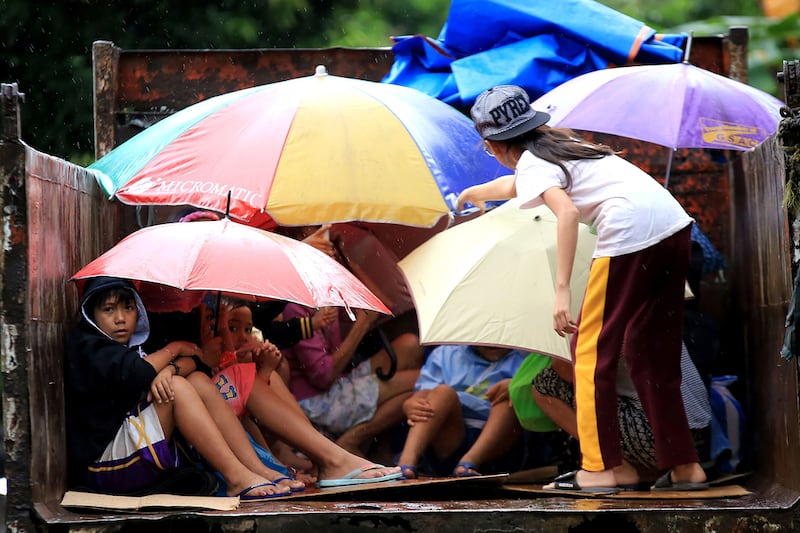Daraga, Philippines // Babies, toddlers and elderly people were loaded onto military trucks in pouring rain in the Philippines on Sunday as tens of thousands fled the path of a powerful typhoon.
Officials warned of waves of up to 2.5-metres high, landslides and flash floods as Nock-Ten closed in on the Bicol peninsula and nearby islands.
More than 100,000 people have left their homes as the typhoon threatens to bring chaos on one of the biggest holidays in the Philippines, with officials saying hundreds of thousands of people could be displaced.
One provincial governor offered roast pig at evacuation centres to entice people to forsake celebrations at home.
“Floods terrify me. Each time I hear about a coming typhoon I want to throw up,” Criselda Buenvenuto, 68, said as she joined neighbours sheltering at a school in the town of Santo Domingo.
The widow lived alone in the kitchen of her house after the rest of it was destroyed during a typhoon ten years ago that killed more than a thousand people.
In the village of Alcala on the slopes of the active Mayon volcano, about 100 babies, toddlers, parents and elderly people were trucked off to another school as rain and strong winds shook trees at midday.
“There are large ash deposits on the slopes [of Mayon]. Heavy rain can dislodge them and bury our homes in mud,” said Alberto Lindo, an official of the farming village of 3,300 people.
“We went around with megaphones and gave instructions to our people to eat breakfast, pack and board the military trucks,” he added.
Nock-Ten, named after a bird found in Laos, hit Bicol on the south of the main island of Luzon on Sunday evening.
The US Joint Typhoon Warning Center forecast sustained winds of 231kph and gusts of 278kph.
The government has forced more than 12,000 residents to move away from the Catanduanes coast where the typhoon first made landfall, said provincial vice governor Shirley Abundo.
In Camarines Sur province near Catanduanes, governor Miguel Villafuerte said on his Facebook page that nearly 90,000 residents were moved out of their homes as part of his “zero casualty” goal.
In another post on Twitter, the governor hinted at the difficulty of convincing people to recognise the approaching danger amid Christmas celebrations.
“Please evacuate, we will offer roast pig at the evacuation centres,” he tweeted.
Weather forecasters said the typhoon would eventually affect an area of nearly 42 million people, including the capital Manila on Monday.
Civil defence officials in Bicol said earlier nearly half a million people in the region were in harm’s way and needed to be moved out.
The military and local governments sent trucks on Christmas Day to clear people from coastal communities and other areas hit by landslides or flash floods in previous storms.
Some 20 typhoons or lesser storms strike the Philippines each year, routinely killing hundreds of people, and Bicol is often the first region to be hit.
It prides itself on having sharpened its disaster response to minimise casualties.
Nock-Ten, which has arrived outside the normal typhoon season, caused all ferry services and commercial flights in Bicol to be suspended.
In the port of Tabaco, stranded passengers sat inside the ferry terminal building with their luggage and children as they stared out at the rough seas, some still hoping to make it across to Catanduanes.
Rescue workers in Manila and the flood-prone central Luzon plains to the north have been put on standby, evacuation centres opened and food and other rations stocked.
The coastguard on Sunday ordered the beaches south of Manila to be cleared of holidaymakers by Monday, while residents of the capital’s seaside slums were warned to leave their homes.
Mammoth tsunami-like waves called storm surges devastated the city of Tacloban and nearby areas when super typhoon Haiyan struck the central Philippines in November 2013, leaving 7,350 people dead or missing.
*Agence France-Presse





